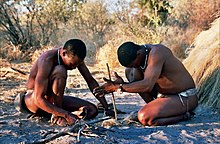Primitive skills: Difference between revisions
Wavelength (talk | contribs) →See also: adding: *Traditional trades |
Sangdeboeuf (talk | contribs) Adding unreferenced tag, removing self-published source |
||
| Line 1: | Line 1: | ||
{{Unreferenced |date=December 2016}} |
|||
[[File:BushmenSan.jpg|thumb|right|[[Bushmen]] from [[Botswana]] demonstrate how to create a [[Firelighting#Friction|friction fire]] using two sticks]] |
[[File:BushmenSan.jpg|thumb|right|[[Bushmen]] from [[Botswana]] demonstrate how to create a [[Firelighting#Friction|friction fire]] using two sticks]] |
||
'''''Primitive skills''''' refers to [[prehistoric]] handicrafts and [[pre-industrial]] technology. Primitive skills are those skills that relate to living off the land, often using handcrafted tools made from naturally gathered materials. Examples of primitive skills include: |
'''''Primitive skills''''' refers to [[prehistoric]] handicrafts and [[pre-industrial]] technology. Primitive skills are those skills that relate to living off the land, often using handcrafted tools made from naturally gathered materials. Examples of primitive skills include: |
||
1. [[foraging]] native plants and animals for food. This skill set often includes medicinal herbalism, edible wild plants, making and deploying primitive traps, snares, fishing rigs, and bows and arrows. |
1. [[foraging]] native plants and animals for food. This skill set often includes medicinal herbalism, edible wild plants, making and deploying primitive traps, snares, fishing rigs, and bows and arrows. |
||
| Line 10: | Line 13: | ||
8. [[Flint-knapping]] is the art of lithic reduction, or breaking rocks at specific angles and places to form working tools like arrowheads. |
8. [[Flint-knapping]] is the art of lithic reduction, or breaking rocks at specific angles and places to form working tools like arrowheads. |
||
Interest in primitive skills has coincided with a resurgence in interest in natural and self-sufficient living techniques. In North America, primitive skills enthusiasts often emulate [[Indigenous peoples of the Americas|Native-American]] traditional crafts. In Europe, primitive skills enthusiasts often practice traditional [[Bronze Age|Bronze]] and [[Iron Age]] art forms. |
Interest in primitive skills has coincided with a resurgence in interest in natural and self-sufficient living techniques. In North America, primitive skills enthusiasts often emulate [[Indigenous peoples of the Americas|Native-American]] traditional crafts. In Europe, primitive skills enthusiasts often practice traditional [[Bronze Age|Bronze]] and [[Iron Age]] art forms. |
||
Although the term is often used interchangeably with wilderness survival, survival, or bushcraft, primitive skills are a specific subset of these subject areas that use few or no "modern" tools. |
Although the term is often used interchangeably with wilderness survival, survival, or bushcraft, primitive skills are a specific subset of these subject areas that use few or no "modern" tools. |
||
Revision as of 16:14, 20 December 2016

Primitive skills refers to prehistoric handicrafts and pre-industrial technology. Primitive skills are those skills that relate to living off the land, often using handcrafted tools made from naturally gathered materials. Examples of primitive skills include: 1. foraging native plants and animals for food. This skill set often includes medicinal herbalism, edible wild plants, making and deploying primitive traps, snares, fishing rigs, and bows and arrows. 2. skinning and preparing game, including hide tanning with bark or brains, harvesting parts of the animal like sinew for bow string and sewing thread. Primitive cooking methods include rock pits, spits, and open-fire. 3. One of the foundational primitive skills is friction fire including the hand drill and the bow-drill methods. 4. basketry includes the identification and harvesting of appropriate materials, and many basket and weaving types. Popular primitive basket materials are pine needles, wild grape vine, and split oak bark. 5. pottery can include the gathering of native clays, shaping and decorating raw vessels, and firing the clay in an open fire 6. weaving including finger weaving, netting, back-strap looms make up a large art-form in and of itself. 7. Pigmenting fiber, leather or pottery with natural dyes like the yellow of goldenrod. 8. Flint-knapping is the art of lithic reduction, or breaking rocks at specific angles and places to form working tools like arrowheads.
Interest in primitive skills has coincided with a resurgence in interest in natural and self-sufficient living techniques. In North America, primitive skills enthusiasts often emulate Native-American traditional crafts. In Europe, primitive skills enthusiasts often practice traditional Bronze and Iron Age art forms.
Although the term is often used interchangeably with wilderness survival, survival, or bushcraft, primitive skills are a specific subset of these subject areas that use few or no "modern" tools.
See also
References
External links
- Rabbitstick and Winter Count Primitive skills events held every year for over 25 years.
- Elements Gathering Primitive skills event that happens every summer in Los Angeles, CA
- Earthskills Rendezvous Non-profit organization that hosts several primitive skills events/gatherings.
- Pine Home: Primitive Skills, Outdoor Safety and Wilderness Survival Instructional site with pics,skills instructions, knife reviews, forum discussing primitive skills, outdoor events and gatherings.
- Midatlantic Primitive Skills Group Non-profit organization that hosts several primitive skills events/gatherings as well as classes in the lithic arts, trapping, tracking and more.
